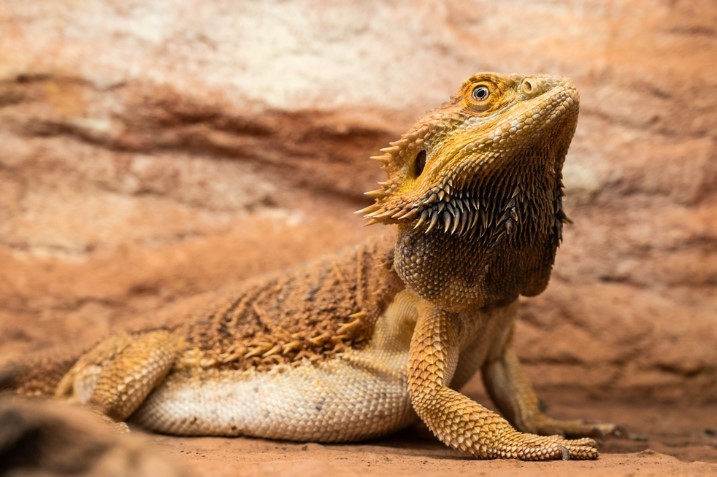Discover 8 Invasive Reptiles in California
↓ Continue Reading To See This Amazing Video
California is known for its diverse wildlife, including several species of reptiles that are native to the state. However, some non-native reptiles have made their way into California over the years, often brought in by human activity. These invasive reptiles can have a significant impact on the local ecosystem. They compete with native species for resources and can even prey on them.
Here are some of California’s most problematic invasive reptiles.
1.) Southern Watersnake (Nerodia fasciata)
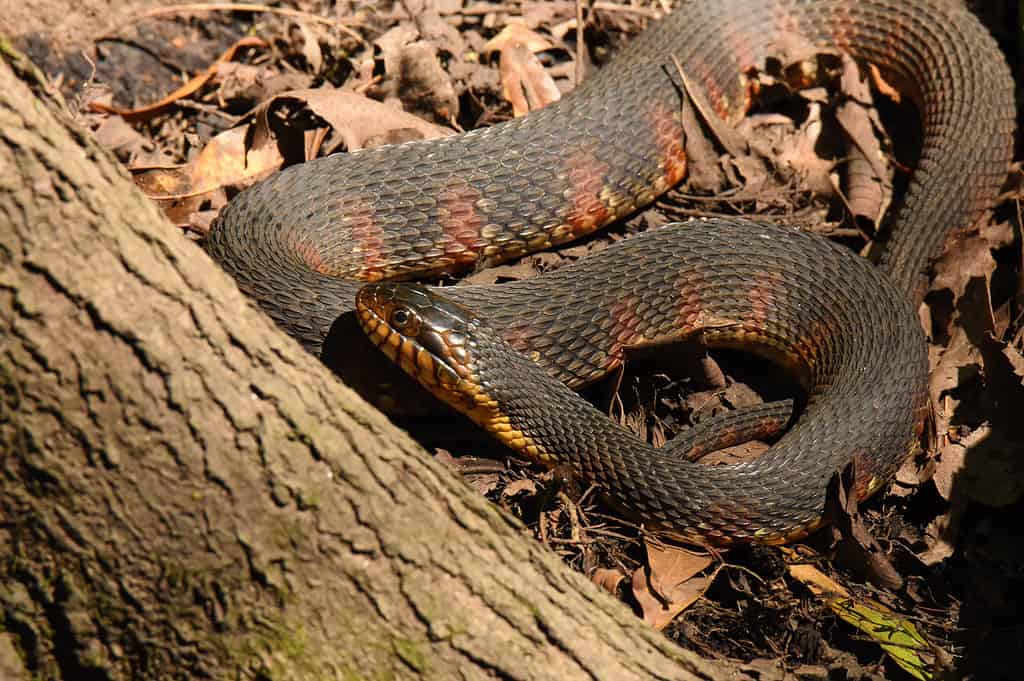
©Gilbert S. Grant/Shutterstock.com
Southern watersnakes, native to southeastern states, are aquatic snakes with thick bodies that can grow up to 5 feet long. Their body color, crossband coloration, and undersides vary between subspecies, with older snakes often appearing dark brown or black. They are not venomous but will emit a foul odor mixed with feces and attack again and again when threatened.
The southern watersnake is most commonly found in Sacramento, Los Angeles, and Yolo counties. These snakes are not commonly kept as pets due to their ill-tempered behavior and unpleasant smell. Consequently, many southern watersnakes that were kept as pets have been released into the wild. This has caused them to become an invasive species in the state.
To control their spread, the state of California categorized all species of the Nerodia genus as restricted in 2008. They cannot be transported, possessed, or imported without a permit.
Southern watersnakes are versatile predators with a diverse diet and are adaptable to various freshwater habitats. They are successful at outcompeting native species for resources, including in Northern California. Here, they threaten the giant garter snake’s survival, which depends on native fish and amphibians in wetland habitats.
2.) Northern Watersnake (Nerodia sipedon)
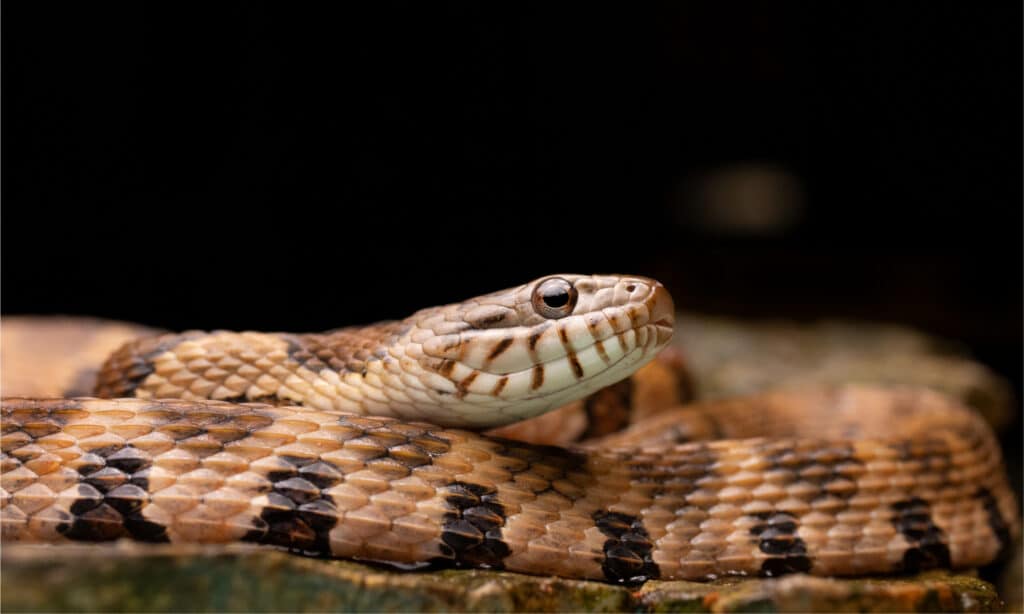
©Radiant Reptilia/Shutterstock.com
Found in central and Eastern North America, the northern watersnake is a heavy-built, water-dweller, 2 to 4 ½ feet long. The body color of this species can vary widely, from reddish-brown to gray to black. As it ages, the northern watersnake’s coloration may become predominantly dark brown or black.
Since 2007, northern watersnakes have been discovered living and reproducing in Kaseberg Creek, located in Placer County’s City of Roseville in California.
The primary way these non-native snakes likely ended up in California is through intentional or accidental release by pet owners. As a result, all species within the Nerodia genus were classified as restricted species in California in 2008. So, without a permit, these species cannot be imported, transported, or possessed.
The primary prey of northern watersnakes are fish and amphibians. Since they are aquatic predators, they may pose a direct threat to freshwater fish and amphibian populations in the state. In addition, if non-native watersnake populations continue to expand, they may end up competing with native garter snakes. This includes the giant garter snake, which is on both the state and federal threatened species list.
3.) Red-Eared Slider (Trachemys scripta elegans)

©effective stock photos/Shutterstock.com
Red-eared sliders are a species of freshwater turtles that are of medium size. They are characterized by their olive brown carapace and skin, which is adorned with yellow stripes. One of the distinctive features of red-eared sliders is the thick red stripe located behind each eye. However, as they age, some individuals may lose their colorful markings and appear dark all over. The adult red-eared sliders can vary in length, ranging from 5 to 11 inches.
Unfortunately, they have gained notoriety for being one of the world’s top 100 invasive species. They cause severe ecological damage.
They have been introduced into several counties throughout California. These turtles are commonly introduced to new areas through the pet trade. They make great pets and are easy to care for. But unfortunately, pet sliders end up in the wild in California after escaping or being released by their owners. In addition, the ceremonial releases by some religions and cultures have also led to introduction to new areas.
Red-eared sliders, an invasive species, pose a threat to native species. They compete for egg-laying sites, basking sites, and food. They can also transmit diseases, such as Salmonella, to both animals and humans. In addition, red-eared sliders have the potential to carry ranavirus, which can be detrimental to various wildlife. These include amphibians, reptiles, and fish.
They can lay up to six clutches per year, each containing up to 30 eggs, leading to a rapid expansion.
4.) Brown Anole (Anolis sagrei)

©Natalia Kuzmina/Shutterstock.com
The brown anole is a lizard species that typically measures between 5 to 8.5 inches in length. Their coloring ranges from brown to grayish hues. They often have whitish or yellowish patterns on their back. Male brown anoles are usually distinguishable from females due to their distinctively colored throat fans, which typically showcase a reddish-orange hue and white edging.
Brown anole originally inhabited the Caribbean region. However, this species has now invaded more than seven counties and the coastal regions of Southern California. The actual cause of their presence in California is still unknown. They may have been accidental stowaways on planes or ships.
The invasive brown anoles pose a significant threat to native lizards as they compete for food and territory, causing the native species to lose their habitats. Their voracious appetite is also harmful to the ecosystem, as they prey on endangered spiders, grubs, and small native lizards, including their eggs. Moreover, brown anoles can introduce parasites into the environment and also carry diseases such as salmonella bacteria.
The brown anoles’ ability to quickly reproduce contributes to their abundance in areas where they have established themselves. Unfortunately, their rapid breeding rate has led to the displacement of native reptiles, causing significant harm to the ecosystem.
5.) Jackson’s Chameleon (Trioceros jacksonii)
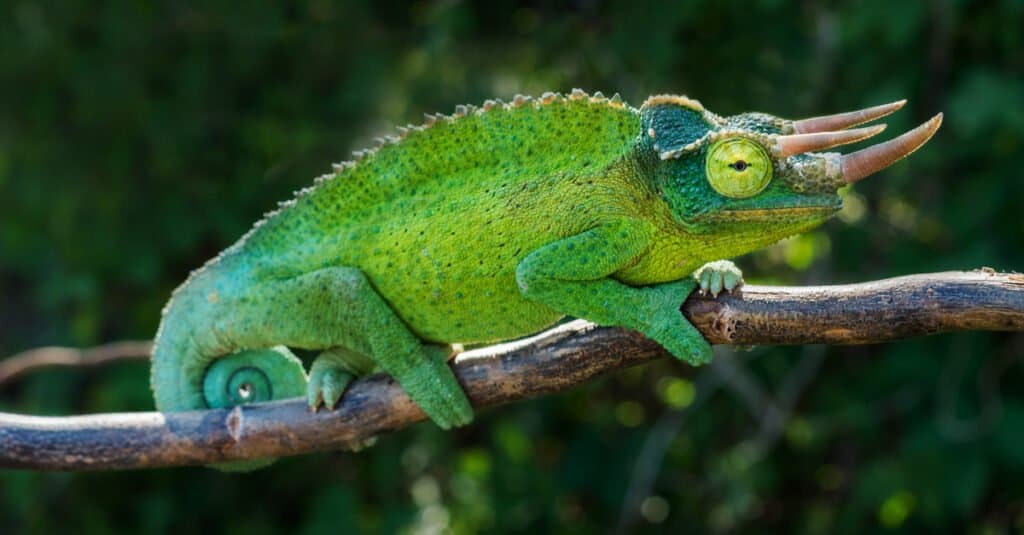
©Jan Bures/Shutterstock.com
Jackson’s chameleon is a species of reptile with characteristic color-changing abilities. These chameleons are typically a vivid shade of green, although some individuals may display hints of blue or yellow. However, their hue can change quickly based on several factors, such as their emotional state, health, and surrounding temperature.
These chameleons can grow up to 13 inches long, but females are typically smaller, averaging around 9 inches in length. The species also has three large horns on its head making it easy to distinguish.
Jackson’s chameleons inhabit various regions of California, such as Laguna Beach, Morro Bay, and possibly the Balboa Park and Palos Verde Peninsula, as well as some neighboring counties.
These reptiles were inadvertently released into the wild when officials from the California Department of Fish and Game left a chameleon cage open during a raid on a suspected illegal reptile dealer in Morro Bay back in 1981. Additionally, some of these chameleons entered California’s ecosystem through the pet trade.
This species is native to the mountainous forests of Tanzania and Kenya, where they thrive in their natural habitats.
However, outside of their native range, these chameleons pose a significant risk to already-endangered native invertebrates by preying on them, which can disrupt the delicate balance of forest ecosystems. This is particularly concerning because many of these invertebrates play crucial roles in the maintenance of forest health.
Additionally, like other reptile and amphibian pets, Jackson’s chameleons can transmit diseases to humans.
6.) Italian Wall Lizard (Podarcis sicula)

©MEDIAIMAG/Shutterstock.com
The most prevalent type of lizard in Southern Italy is easily recognizable due to its physical appearance. This species displays a range of colors, including green, yellowish, tan, and light brown, and typically has a whitish, greyish, or greenish belly. During the springtime, male lizards may exhibit a reddish tinge under their jaw, throat, and front legs. Italian wall lizards are also called ruin lizards because they are commonly found on ancient ruins in Italy.
In terms of size, this particular lizard species generally measures between 5½ to 8 inches in total length when fully grown.
It all started when a resident brought a handful of Italian wall lizards back from Sicily in 1994 and released them in his backyard. With four males and three females, the lizards adapted and multiplied.
Now, almost 20 years later, the Italian wall lizard population in California has virtually taken over the region within a five-block radius from where they were initially introduced.
Italian wall lizards can hitch rides on cargo shipments, particularly those carrying garden supplies or plants, and through the pet trade. This has resulted in their spread beyond their original habitat.
However, the introduction of Italian wall lizards in non-native areas can have negative consequences for the native lizard populations. They are strong competitors and can outcompete native lizards for food and habitat, leading to a potential decline in the number of native species.
7.) Mediterranean House Gecko (Hemidactylus turcicus)
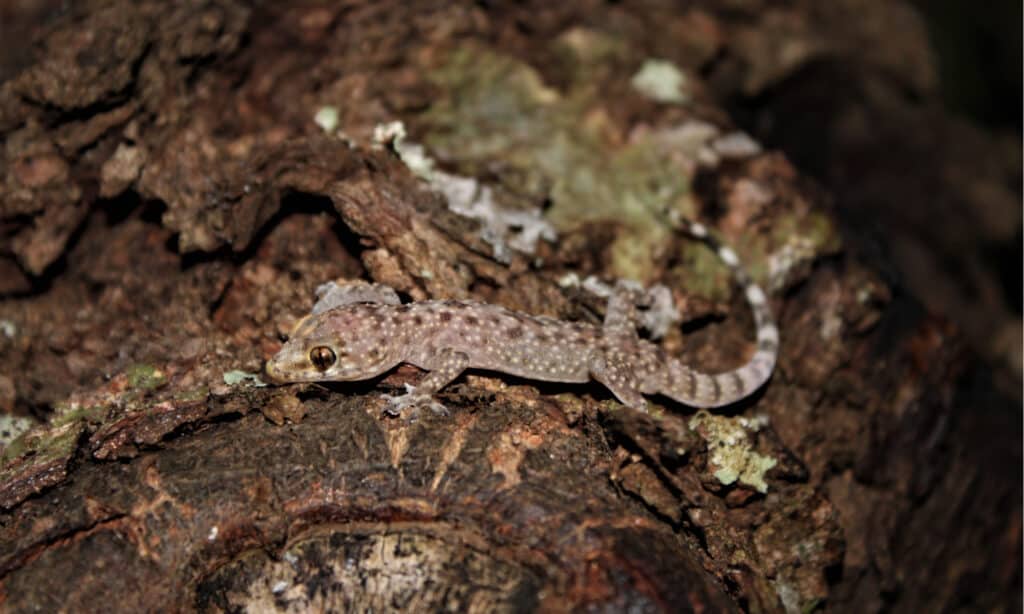
©Tucker Heptinstall/Shutterstock.com
These small creatures feed on insects and are typically no larger than 5.9 inches. They have distinct physical characteristics, such as their large eyes with no eyelids and elliptical pupils. The species also has tan-colored or purple skin with black spots, often accompanied by stripes on their tails. Their undersides or bellies are slightly transparent.
Despite not being native to California, the Mediterranean house gecko has become a well-known species and is included in any list of geckos present in the state. They were introduced to California through the transportation of imported plants that contained their egg clutches. Due to their ability to adapt to various environments, their population grew at a faster rate than that of native geckos.
The Mediterranean house gecko is invasive and consumes a significant amount of food resources. Although it is unclear whether the presence of the Mediterranean gecko has any negative impact on native species, their depletion of resources is a cause for concern. Additionally, they are among the most widespread non-native lizard species in the United States.
The Mediterranean gecko’s capacity for rapid breeding and resilience to pesticides has enabled them to establish stable populations throughout the state.
8.) Common Snapping Turtle (Chelydra serpentina)
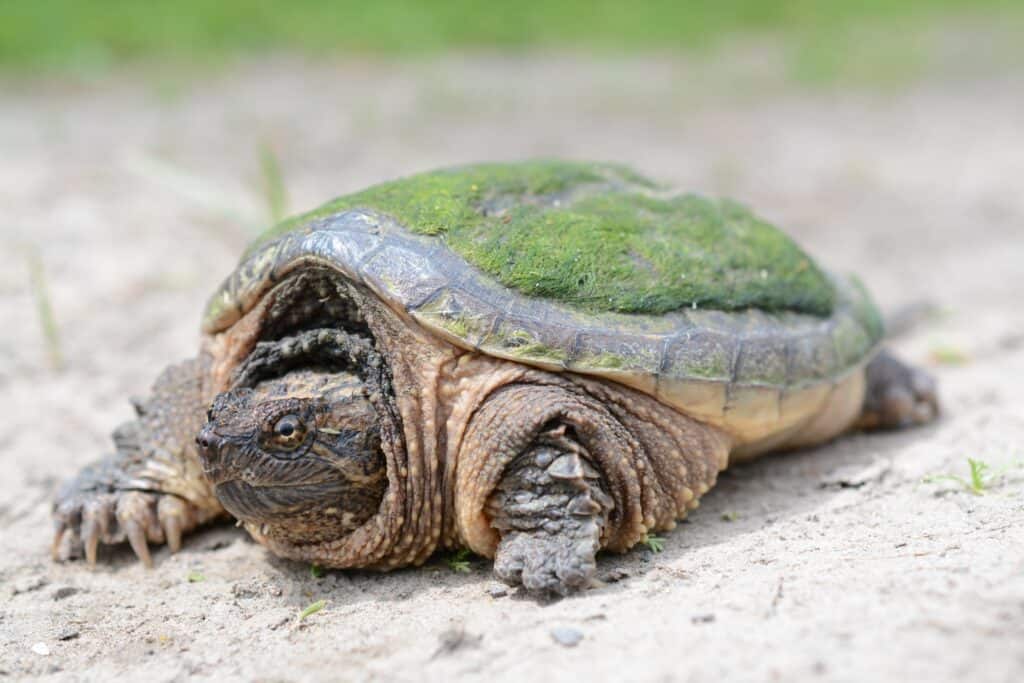
©Trevor Meunier/Shutterstock.com
The common snapping turtle, a sizable freshwater turtle species, has a natural habitat that spans several regions throughout North America. Its carapace can vary in color and may be covered in moss. Its tail is long with bony plates, often measuring as long as or longer than its shell. The snapping turtle typically measures between 8 and 14 inches in length.
The common snapping turtle is an illegal species in California, as it is not native to the state. Possession or release is prohibited under California Fish & Game regulations. Despite this, common snapping turtles inhabit more than 16 states, highlighting their invasive nature and abundance in certain areas.
The precise cause of common snapping turtles in California is unknown. However, some speculate that negligent pet owners are responsible for releasing them. It is unclear whether these turtles reproduce in the state.
Common snapping turtles tend to seek out habitats with ample aquatic vegetation for cover and prey, such as insects, fish, frogs, and birds. Their voracious appetite makes them a potential predator of native animals, thereby posing a threat to the ecosystem.
As one of the largest turtle species found in California, common snapping turtles may threaten native turtle populations by displacing them from their habitats, out-competing them for food, and even preying on native turtle hatchlings.

